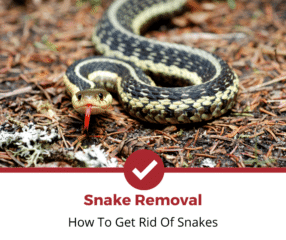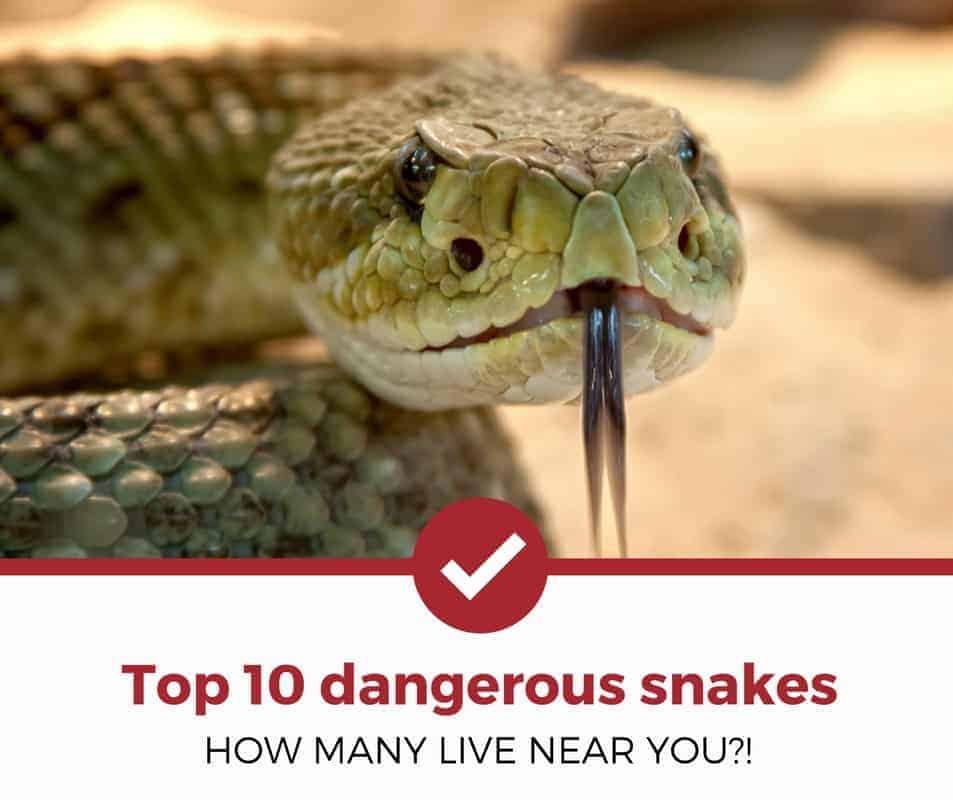According to theCenters for Disease Control (CDC), snakes typically bite an average of 7,500 people each year in the U.S. Those who die from them number over 400.
The best way to avoid snake bites is through prevention. Here, our wildlife experts show you:
- How To Make Habitat Modifications That Matter
- How To Install Snake Fencing Without Paying a Fortune
- The Most Popular Snake Repellents and Their Drawbacks
- How To Limit Those Things That Attract Snakes to Your Yard

Ed has been working in the pest control industry for years helping 1,000's of homeowners navigate the world of insect and rodent management. He manages Pest Strategies now helping homeowners around the world!

Table of Contents
如何保持Snakes Away
It is not enough toget rid of snakes around your home. You have to keep them from returning. These are the steps to take so your home can remain snake-free.
1. Reduce Food Sources
Adult snakes feed on rodents such as rats and mice. Removing pet food bowls from your yard at night is an excellent first step toward reducing rodent populations. Still, the most preferred strategy is to feed pets indoors instead.
An even better solution to your venomous snake problem is to enlist the help of non-venomous snakes. For example,king snakes have a voracious appetiteand are willing to eat harmful copperheads, cottonmouths, and even rattlesnakes.
The rat snake, on the other hand, does not normally feast on other snakes. Instead, it will help you get rid of any mice or rats in your yard that attract venomous snakes.
2. Limit Snake Cover
Tall grass and weeds attract snakes to your yard by providing cover, which is especially true for dangerous pit vipers. These venomous snakes are ambush predators that lie in wait for their prey.
For that reason, it is preferable to mow your lawn regularly. Keeping your grass short will also thwart other pests such as raccoons and mosquitoes.
Woodpiles should be stacked tightly and kept at least 20 feet from your house — also, stack lumber and building materials away from outside walls.
3. Install Snake Fencing
Snake fencing keeps snakes from entering your yard. Here are thesteps to install itaround your property.
Step1.Dig a six-inch trench under your existing fence, which can either be chainlink, wrought iron, or wood.
Step 2.Leave the flimsy chicken wire for the chicken coop. Instead, select a 19-gauge, 1/4-inch galvanized steel wire mesh for the project. It needs to be 36 inches wide and at least the length of your fence.
Step 3.Place the wire mesh into the trench. Use a carpenter’s level to avoid an uneven appearance at the top. Also, there should be 30 inches of exposed wire mesh to cover the existing fence.
Step 4.Use heavy-duty zip ties at 18-inch intervals to secure the mesh. Continue using a carpenter’s level to ensure the top edge looks even.
Step 5.For greater security, use concrete where the wire mesh meets each post. This will anchor it to the ground.
Step 6.Fill in the rest of the trench with dirt, being careful to keep the bottom of the mesh continuing in a straight line.
Remember, if you’re hiring someone to complete the task of building a snake-proof fence for you, insist on 1/4-inch wire mesh instead of larger sizes. Check out this video for more information on why this is so important.
4. Trapping Snakes
Setting glue trapsis another favorite DIY trick homeowners use to keep snakes away. They are especially useful for small, non-venomous species, including garter snakes.
However, they should not be used for large venomous snakes such as cottonmouths or rattlesnakes. Even when stuck to a glue board, it can take a long time for them to die, making the animal even more dangerous.
While it is true that copperheads and coral snakes are much smaller, it is still best not to trap them. Even while trapped, they can still bite you if they are alive.
5. Natural Snake Repellents
Contrary to popular opinion, snakes have aheightened sense of smell. But instead of using only their nose, they can also employ their forked tongue to extract more information from their environment than any human.
This keen awareness of their surroundings can also help them sense danger ahead. For example, researchers in a preliminary study concluded thatcertain essential oilscould repel snakes.
The drawback to commercial snake repellents is their relatively short residual effect. In other words, they tend not to last long, so you have to reapply them at regular intervals. Still, they show promise as a defense against snake intrusions when used with other snake control measures.
Examples of essential oils used to repel snakes include:
- Cedarwood
- Lemongrass
- Ginger
- Cinnamon oils
What Not To Use
Never use mothballs to repel snakes since the EPA does not register them as snake repellents. Besides, when placed within confined crawlspaces, the toxic fumes can make their way into the rest of your house.

All snakes drink water.
Having large amounts of pooled water in your yard invites several types of snakes and not just the ones that live in oceans, rivers, and ponds.
Find A Local Exterminator
Things That Attract Snakes
Several factors contribute to snakes being lured to your yard, most of which are related to their survival. By limiting these variables, you can slowly make your home unattractive to these unwanted guests.
Food
Adult snakes primarily eat small animals, including:
- Lizards
- Rodents
- Frogs
- Birds
- Other snakes
Juvenile snakes, in contrast, sometimes eat small invertebrates, such as:
- Grasshoppers
- Cicada bugs
- Beetles
- Millipedes
- Spiders
Limiting these food sources will go a long way in preventing snake infestations. The best way to do that is by scheduling regular pest control visits.

水
All snakes drink water.However, when you live in the desert and have a pool in your backyard, it becomes a magnet for snakes.
That also goes for flood irrigation. Having large amounts of pooled water in your yard invites several types of snakes and not just the ones that live in oceans, rivers, and ponds.
Shelter
Several reasons exist for snakes needing shelter. For example:
- To protect against sun damage
- To stay warm
- To take refuge from predators
- To wait in ambush for prey
Leaf litter and piles of mulchare perfect spots for snakes to seek shelter. In addition, landscaping featuring several large rocks also makes ideal hiding places for snakes.
One Last Word of Advice
Most people have a fear of snakes, so it is only natural if you do as well. Therefore, it is even more crucial to keep them away from your home.
Although most snake species are beneficial for the environment, they cancause health problems if they bite. That is why it makes sense to seek the help of a professional pest control company to remove snakes and other harmful critters from your property.



